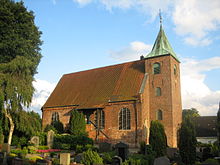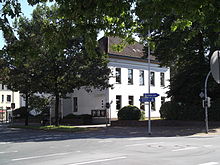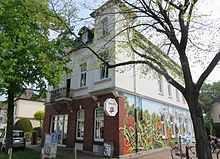Easter castle
|
Easter castle
City of Oldenburg (Oldb)
Coordinates: 53 ° 7 ′ 43 ″ N , 8 ° 14 ′ 7 ″ E
|
|
|---|---|
| Residents : | 11,980 (Dec. 31, 2015) |
| Incorporation : | October 1, 1922 |
| Area code : | 0441 |
Easter Castle is a district of the Lower Saxony city of Oldenburg and has around 12,000 inhabitants (excluding Drielake ).
history

The place is mentioned for the first time in the Count's Salbuch from 1428 with "de twe hus to Osterenborch". In 1616, Osternburg was legally an independent municipality. Count Anton Günther donated its own church to the community , so that Easter Castle became a parish . The count also created the “Your Princely Grace Pleasure Garden on the Wunderburg”, reminiscent of the street names in Easter Castle. With the French administrative reform of 1811, the municipality received its own full-time mayor (Maire), who after the end of the French occupation in 1814 was called parish vogt. According to the new municipal code of 1856, the new municipal council appointed a municipality leader. With the fall of the Kingdom of Hanover in 1866, the railway connection of Oldenburg and thus Easter Castle could be realized in 1876 . A rail connection to the large industrial plants and a large, now disused marshalling yard with railway workers' apartments were built in Easter Castle .
From 1859 to 1919, the Oldenburg Dragoon Regiment No. 19 was stationed in Osternburg . The Dragoon barracks was located on Bremer Straße and was demolished around 1980. Today there are Bundeswehr offices on the site .
From June to September 1894, a large strike by glassworks took place in Easter Castle. On the late evening of August 10, the glassworks worker Carl Ohlendorf on Langenweg (today Stedinger Straße), at today's house number 33, was insulted as a strike breaker by striking work colleagues and assaulted. Ohlendorf was seriously injured by six knife wounds and died a few days later in the city's Evangelical Hospital. The perpetrators were arrested by members of the gendarmerie the day after the crime . The main perpetrator, Hermann Bulle, was sentenced to four years in prison, three secondary perpetrators to six months imprisonment.
In order to prevent further incidents of this kind, the glassworks was occupied by four gendarmes. Ten additional officers patrolled Easter Castle day and night. The strike, one of the largest that ever took place in Oldenburg and lasted a good three months, was stopped in September 1894 because the plant management had recruited new workers from southern and western Germany.
From August 11, 1891 to March 31, 1892, a newspaper was published in Easter Castle, Der Osternburger. Entertainment and advertising paper for the community of Osternburg u. The surrounding area , which was reformist in tendency and was first produced in Oldenburg, then in Berlin by Deutsche Verlags- und Buchdruck AG. The sheets are archived in the Oldenburg State Library .
In 1913 the community had 13,000 inhabitants and was one of the most important industrial locations in the Grand Duchy of Oldenburg . The following large companies were located in Osternburg before 1914: the Oldenburgische Glashütte, the warps spinning mill, the Osterburg gasworks, the Beyer glass mold factory and the large construction company Westerholt. There were also many small businesses.
On October 1, 1922, the municipalities of Osternburg and Oldenburg were united by law, and Easter Castle became part of Oldenburg. In the course of the incorporation, a police station was set up in Ulmenstrasse (today's Bundeswehr site) in 1924 , which was relocated to Cloppenburger Strasse in 1937 (former school building at the confluence of Gorch-Fock-Strasse) and in 1954 to Bremer Strasse 25. After the dissolution in 1984, there was only one police station in Osternburg, which was no longer manned at night.
After the Hunte Bridge was blown up in April 1945 and until it was provisionally rebuilt in August 1945, the Osternburg station was temporarily the terminus for trains from Osnabrück .
Natural monument
The oldest tree in Oldenburg, a pedunculate oak, can be found in Easter Castle. Their age is estimated to be around 460 years. The trunk is almost 6 meters in circumference.
Companies
In 1845 the concession to build a glass factory was granted. The Oldenburgische Glashütte was established in the then rural community of Osternburg between today's Stedinger Strasse and the Hunte. From 1847 onwards, beer mugs, lamp cylinders and demijohns, among other things, were produced . By 1891 up to 15,000 bottles were being produced every day. In 1957 Gerresheim Glas AG took over the bankrupt factory. Buildings were demolished and new machines were used. As a result, the glassworks developed into one of the largest industrial companies in Oldenburg. In 1970 the factory was producing an average of 1.2 million bottles of drinks a day. Despite these high production figures, the plant was closed in 1983; today, the Peguform factory halls , in which car parts are manufactured, are located there. In 1891, Ludwig Freytag, who was born in Osternburg, founded a construction company that currently employs 1,300 people. From 1916 to 1926 the Wagenbauanstalt Oldenburg was located in Easterburg , which among other things manufactured trams and motorcycles . In 1917 the Brand Werft was relocated from the Oldenburg side of the Hunte to the Easter burger. Between 1924 and 1935, the Zentralviehmarkt was located between Bremer Heerstrasse, Harmoniestrasse and Dragonerstrasse, and the Oldenburg Herdbook was located on Wunderburgstrasse in the 1940s and 1950s .
traffic
Osterburg is connected to the local public transport system by several city bus routes operated by Oldenburger Verkehr und Wasser GmbH : Route 330 serves the suburban district of Drielake . Stedinger Straße is served by line 340 (Blankenburg Abbey) / ( IKEA ). The core of Osternburg in the Bremer Straße area is connected to the city center by lines 302 (Borchersweg), 313/323 ( Krusenbusch ), 304 ( Bümmerstede ) and 311/321 ( Kreyenbrück ).
The Oldenburg marshalling yard used to be located in the southern neighboring district of Krusenbusch . Even today, Easter Castle is cut through by the Oldenburg – Osnabrück railway and the Hemmelsberg curve to the Bremen – Oldenburg railway . The NordWestBahn runs every hour between Wilhelmshaven and Osnabrück , but the former Oldenburg-Osternburg stop has not been served since 1979 and has now been closed. In the course of the commissioning of the Jade-Weser-Port , a route expansion has been discussed for years, and local politicians are calling for a bypass route.
The coastal channel is of great importance for shipping . The Hemmelsbäker Canal, the Easter Burger Canal and the Drielaker Canal are used for drainage .
Personalities
- Johann Peter Ahlers (1724–1793), Royal. Danish captain and Duke of Oldenburg forester and chamber councilor
- Friedrich Albers (1881–1936), liberal politician and member of the Oldenburg state parliament
- Julius Friedrich Wilhelm Bosse (1788–1864), court gardener and botanist; last lived at Stedinger Straße 103
- Theodor Ahlrichs (1866–1937), Evangelical Lutheran theologian; was assistant preacher in Easter Castle from 1895 to March 1879 and lived at Ulmenstrasse 3
- Carl Dinklage (1868–1941), German industrialist and chairman of the board of the Oldenburger Glashütte
- Heinrich Bockelmann (1870–1945), banker and diplomat; Grandfather of Udo Juergens
- Hermann Ehlers (1904–1954), President of the German Bundestag (Ehlers lived on Brunnenstrasse, which was renamed Hermann-Ehlers-Strasse after his death)
- Wilhelm Gideon (1898–1977), SS-Hauptsturmführer and commandant of the Groß-Rosen concentration camp
- Franz Klüsner (1837–1916), influential Methodist preacher
- Carl Ramsauer (1879–1955), German physicist, discovered the Ramsauer effect
- Alexander von Rennenkampff (1783–1854), Imperial Russian Rittmeister
- Ernst Rodiek (1903–1980), politician (SPD), Member of the Bundestag
- Albert Freiherr von Schrenck-Notzing (1862–1929), pioneer of psychotherapy and parapsychology
- Johann Schütte (1873–1940), shipbuilding engineer, university professor for shipbuilding, airship designer and entrepreneur
- Wilhelm Stählin (1883–1975), German Lutheran theologian, pastor in Easterburg, later became regional bishop of Oldenburg
- Karl von Wedel (1842–1919), Prussian cavalry general, German ambassador in Rome and Vienna
- Wilhelm Wrobel (1900–1961), painter and sculptor
literature
- Matthias Schachtschneider: Easter Castle. A place with many faces. Oldenburg 1999.
- Geert Claussen, Sven Claussen: Search for traces in Easter Castle. Oldenburg views. Oldenburg 2009.
- Walter Barton: Bibliography of the Oldenburg press. In: Oldenburg Yearbook. Volume 57, 1957, p. 55.
- Dirk Fass: True crime stories from the Oldenburger Land. Isensee, Oldenburg 2013, ISBN 978-3-7308-1047-7 , p. 50ff.
- City of Oldenburg (Ed.): Oldenburg 1914–1918. A source volume on the everyday, social, military and mental history of the city of Oldenburg in the First World War (= publications of the Oldenburg City Archives. Volume 7). Isensee, Oldenburg 2014, ISBN 978-3-7308-1080-4 .
Web links
Individual evidence
- ↑ Population statistics of the city of Oldenburg ( Memento of the original from April 13, 2014 in the Internet Archive ) Info: The archive link was inserted automatically and has not yet been checked. Please check the original and archive link according to the instructions and then remove this notice.
- ^ Hermann Lübbing: Oldenburger Salbuch . Stalling, Oldenburg 1965, p. 38, No. 58 .
- ↑ Martin Teller : On the location of the count's baroque gardens in the Oldenburg cityscape. Retrieved March 14, 2014 .
- ↑ Forgotten stops on the Oldenburg - Osnabrück railway line
- ↑ ND 2 in the directory of natural monuments in Oldenburg
- ^ Nabu Oldenburger Land: Oldenburg Tree Path . Oldenburg 2012.
- ↑ Company profile , accessed on August 3, 2015.
- ↑ Osterburger Bahnhof sold. In: Nordwestzeitung . November 14, 2012.


